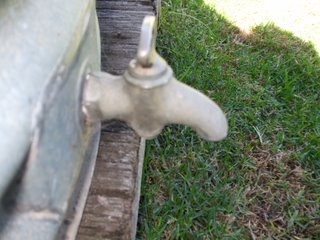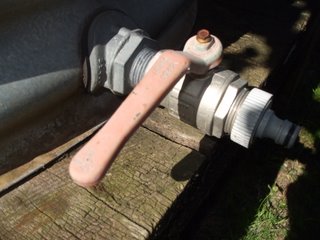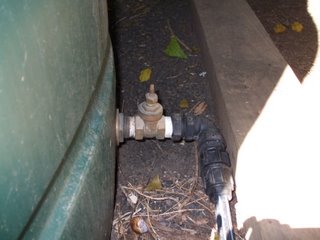We have somewhat over 10,000 litres of rainwater storage capacity at our place consisting of two approximately 2,500 litre corrugated galvanised steel tanks, a 5,500 litre plastic tank by the side of the house and several water barrels and a converted wheelie bin. One of the galvanised tanks has a simple on/off tap and that is the one that I use to fill up the chooks water, watering cans, buckets and just about any other container around the place. The tap doesn’t really lend itself to connecting a hose so it usually just gets used to fill stuff. The water is probably OK but for drinking purposes we fill up a ceramic gravity filter water reservoir in the kitchen.

The other galvanised tank has a ball valve with a press on hose fitting so that I can fit the garden hose to it. That works well and is the one I usually use to fill up the in-ground bath that we use to grow our water plants – water chestnuts and arrow in. In summer the transpiration of the mass of water plants is considerable so I run water out of the tank every week or two to top up the bath.

The outlet for the 5500 litre tank is a small gate valve with a threaded connector that takes a press 0n garden house outlet fitting. Not long after we got the tank in we had some good rains which mostly filled it and all I had was the hose fitting connected to it so I could water the front garden. I got into the habit of rapping on the tank as I walked past it, and one day I did it and got a hollow sound, the damn thing was empty! Whether someone had watered and forgot to turn it off or the neighbourhood kids turned it on and left it I will never know, but I was not impressed! So after that I unscrewed the nut that secured the hand wheel and then made sure I turned it off and removed the hand wheel when I was finished watering. No sense tempting fate a second time, or creating more ulcers for myself.

I have now plumbed in the tank using a small Jabsco 60psi washdown 12 volt pump with a built in pressure switch wired into the 12 volt system and connected to 20mm diameter plastic water pipe. The pipe is plumbed in to two taps, one over the twin tub washing machine on the back deck and the other over the sink down near the greenhouse. It was fun running the pipe under the house to the back deck but at least the son-in-law was living with us and I was able to con him into climbing under and running the pipe, although I wouldn’t recommend this approach for everyone. (it can strain the friendship!).

The pump is wired directly from the switchboard in the garage (I ran the wiring under the house this time) through a surface mounted switch and even thought it has a pressure switch (when the pump gets the line up to a pressure of 60 PSI the pump is automatically turned off) I switch the pump off at this switch when it is not in use. I do this because the system would be under constant pressure and one small failure would led to the pump draining the tank then burning out and possibly causing a fire because they are not designed to run dry. This means to use the system I have to go out and place the hand wheel on the tank valve and open it fully then go into the garage and turn on the pump. A bit of a pain but it means there is no unauthorised water loss.
If you were going to leave the pump on full time you would need to run your water supply pipes in conventional copper plumbing, which imposed a cost I was not prepared for and required a level of skill I don’t yet possess. The pump uses about 5 amps when delivering water to the hose, but can consume in excess of 10 amps when building up pressure just before it cuts out. Our current 12 volt system seems to handle the load of the pump with little difficulty.

The pipe that I use to run the water is easy to work with and doesn’t require any special skills. It cuts easily with a Stanley knife and has press fit fittings that are easy to use. Just cut the pipe to length, slide on the screw cap and locking ring, push the pipe into the fitting and then tighten up the screw cap so that the locking ring is pulled into the fitting, forming a seal. As always, when plumbing with screw fittings a little Teflon tape goes a long way to stopping leaks before they start.
The tap over the washing machine is one that gets used the most and is the one I use to water the veggies with. The pressure is enough so that if I use the “shower” setting on the trigger nozzle I get a good enough flow to keep the veggies watered without taking so long I have to stay up all night.
So far I haven’t emptied the big tank before we have had rain to re-fill it and it has certainly helped me keep the veggies going through the dry weather we have had lately. In the future I would like to run a line into the kitchen so that we could have tank water on tap, but I have a few technical problems to solve first.




